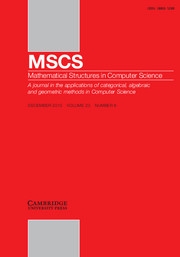No CrossRef data available.
Article contents
Paraconsistent transition structures: compositional principles and a modal logic
Published online by Cambridge University Press: 04 July 2025
Abstract
Often in Software Engineering, a modeling formalism has to support scenarios of inconsistency in which several requirements either reinforce or contradict each other. Paraconsistent transition systems are proposed in this paper as one such formalism: states evolve through two accessibility relations capturing weighted evidence of a transition or its absence, respectively. Their weights come, parametrically, from a residuated lattice. This paper explores both i) a category of these systems, and the corresponding compositional operators and ii) a modal logic to reason upon them. Furthermore, two notions of crisp and graded simulation and bisimulation are introduced in order to relate two paraconsistent transition systems. Finally, results of modal invariance, for specific subsets of formulas, are discussed.
Information
- Type
- Special issue: LSFA 2021 and LSFA 2022
- Information
- Copyright
- © The Author(s), 2025. Published by Cambridge University Press


